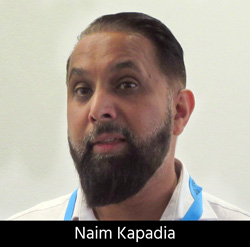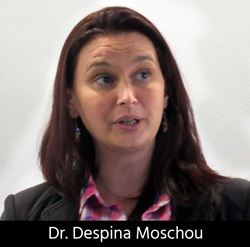|
|
ICT Annual Symposium Review June 15th 2022 British Motor Museum, Warwickshire |
 |
The British Motor Museum in Warwickshire, housing the world's largest collection of historic British cars, was venue for the 2022 Annual Symposium of the Institute of Circuit Technology on June 8, which attracted a substantial gathering of manufacturers and suppliers from the UK printed circuit industry. ICT chair Emma Hudson reflected upon lessons learned during the pandemic lock-down and how the industry has successfully adapted to circumstances. She commented that the UK’s PCB fabricators are extremely busy, as she introduced an outstanding conference programme including a keynote from the incomparable Happy Holden. |
 |
Naim Kapadia: Services at the MTC He explained some of the services provided at MTC for consultation with proposed new manufacturing businesses, engineering upskilling, and training of apprentices in their own academy. They also operate an events and conference centre. To date, they have completed around 1,400 industrial-funded projects, where all the IP generated is owned by the individual company. They also participate in government-backed collaborative R&D projects. Originally focused on aerospace, they have progressed into defence and security, and latterly into large robotics in the construction industry. The aim of the electronics section that Kapadia manages is to develop Smart factory operation of their in-house automated surface-mount electronics manufacturing facility, which includes several items of legacy equipment. This will provide a Smart factory demonstrator to assist electronics manufacturers to advance from traditional procedures to a future state of connecting people and machines, merging product and customer data to achieve total manufacturing integration with a digital thread across supply chains. The project is supported by members of the MTC from a variety of industrial sectors. Kapadia explained that MTC’s Smart Factory demonstrator uses IPC’s Connected Factory Exchange (CFX) industry-developed open standard, enabling machines to communicate with other machines and systems across manufacturing facilities and the supply chain, with standardised machine communication message sets. The demonstrator will enable electronics manufacturing businesses to trial digital technologies in a risk-free environment, without disrupting day-to-day production. |
 |
Despina Moschou: Improving Biomedical Technology She reviewed the development of Lab-on-PCB technology. Although the principle was first suggested in the 1990s, it was side-lined by easier microfluidic fabrication processes. But with more recent focus of Lab-on-Chip integration, PCBs have offered the ideal platform because of the long-standing industrial infrastructure which enables low-cost commercial upscaling, adequate microfabrication capabilities, and the opportunity for intuitive integration of electronics. She drew a parallel with the development of the computer: whereas early computers occupied entire buildings, they have shrunk to microscopic dimensions. So it is that biochemical laboratories can be shrunk into micro-total-analysis systems (μTAS), although a significant constituent is the microfluidics components: separators, channels, filters, pumps, valves, and mixers, in addition to the electronics. She commented that when she first started talking with the PCB industry, what she was proposing sounded like science fiction; she was pleased to report that this is now a reality. Before COVID-19, it had often been necessary to explain the justification for the concept; this is no longer the case since there are simply not enough laboratories to handle the testing involved. The solution is to miniaturise the laboratory and mass-produce it so that testing can be done locally—either at home or in the GP surgery. Not just in extreme pandemic situations, but in many other aspects of healthcare, for example, testing in diabetes and cancer diagnosis, or testing for pathogens in water and milk. She showed several examples of PCB-based microfluidics and biosensors, including a fully integrated ELISA Lab-on-PCB cartridge with reference electrodes, sensing electrodes, and microfluidics. (ELISA means enzyme-linked immunosorbent assay, commonly used to measure antibodies, antigens, proteins, and glycoproteins in biological samples.) From a manufacturing point of view, as yet there are no standards or design rules. Many academics are doing research, but no one is actually making a commercial product—the same “valley of death” that Naim Kapadia referred to. There are many questions to be answered. However, the PCB industry is accustomed to working to international standards, with standardised processes, materials and practices. There are many PCB factories already established and therefore many opportunities to progress the Lab-on-PCB concept. Moschou showed an example of a handheld sample-in-answer-out genetic-based COVID-19 diagnostic test device that completes each stage of a COVID test—taking a sample, identifying specific DNA sequences, and displaying results—within 10 minutes. The genetic analysis is superior to protein-based rapid tests currently in use. Prototypes are undergoing clinical trials. Other projects in her research group include a pre-diabetes diagnostic test for mass screening of children, supplied as a disposable wearable patch; enzyme-assisted electrochemical sensors; non-enzymatic electrochemical sensors; Lab-on-PCB devices for measuring water quality parameters; and Lab-on-PCB microsystems for quantification of water in oil and aviation fuel. |
 |
Michael Ford: Embracing the Smart Factory “The barrier for entry into Smart manufacturing has been breached,” Ford exclaimed. His presentation discussed how standards-based industrial-internet-of-things message exchange has been liberating access to data, eliminating the need for bespoke interface development, data interpretation or translation, middleware, or even specialist knowledge of other hardware or software solutions. “A perfect storm is facing manufacturing right now,” he said. His opening slide listed the immediate drivers for the reassessment of goals and priorities in the industry: disruption of labour caused by the COVID pandemic, supply-chain challenges and shortages, shifts in global politics revealing critical dependencies, the energy crisis and the environmental crisis. The results were not only the creation of turbulence but also the creation of opportunity; industry needed resilience, agility, and a strategy. Although the Industry 4.0 concept has been around for several years it has not really taken off, mainly because of cost and risk barriers to entry, together with companies’ inability to adapt to market changes. To make Industry 4.0 happen, it is necessary for data to be exchanged fairly by the Smart infrastructure, which is required to support the most modest to the most established operation. The answer is not a single solution from a big company intent on dominating the market, with its associated costs and proprietary and competitive restrictions. The answer lies in data interoperability: all manufacturing is inclusive of multiple vendors, each generating and consuming data, and needing to exchange and share it securely and efficiently. Historically there were many de facto “standards,” generally modelled around solutions that pre-dated holistic digital manufacturing, with an ecosystem based on customisation and middleware. There was an obvious need for a new standard that would address the need for full digital interoperability, eliminate cost and risk barriers for Smart manufacturing, and use modern, secure, data exchange technologies. With a series of increasingly complex schematics representing the units of a production line communicating with each other and with an IT network, Ford illustrated the hidden challenges of machine communication, with dozens of “my way” interfaces and firewall rules at enormous cost. His ideal example showed standard secure connections between individual machines and the IT network, with a uniform “one-rule” firewall, no middleware, no customisation, and a single language. This was what was provided by the IPC Connected Factory Exchange (CFX) standard, enabling complete bi-directional exchange of data, covering every aspect of manufacturing visibility, management, control, and traceability, and setting each event into context. Ford sees the Industry 4.0 Smart Factory ecosystem taking shape. It includes multiple, interoperable solutions from machine vendors and MES software solution providers, as well as self-developed solutions providing anything from simple dashboards displaying project-based experimental KPIs, to complex “AI” algorithms analysing patterns in the variation of data. Design, quality, materials, delivery, costs, agility, and flexibility all benefit within a single flexible ecosystem, based on interoperability and shared context of information. |
 |
Tom Eldridge: Nanotube Technology He explained the structure of carbon nanotubes, allotropes of carbon in the form of cylindrical molecules, which are effectively rolled-up sheets of graphene with extremely high electrical and thermal conductivity. Chasm has developed a production process that enables precise control of the diameter, length, and geometry of nanotubes. This is based on their proprietary catalyst and uses a rotary kiln reactor to synthesise carbon nanotubes and nanotube-hybrid materials from ethylene. Carbon nanotubes are used in the formulation of screen printing inks, with polymer binders and proprietary ink vehicles, to produce low-cost flexible printed electronics. There is an increasing demand for alternatives to indium tin oxide for transparent conductors. Chasm has developed a hybrid ink based on carbon nanotubes and silver nanowires, which offers technical and functional benefits in terms of flexibility, formability, transparency, and cost of patterning. Eldridge showed examples of applications of transparent flexible printed electronics in the automotive industry, especially in human-machine-interface capacitive touch controls that can be 3D formed and incorporated into the interior structure of the vehicle. There is increasing utilisation of the technology in transparent UHF antennas for 5G, IoT, Wi-Fi, TV, radio, GPS, Bluetooth, and near-field communication. A further application area is in transparent heaters for de-icing ADAS sensors, headlights, and windows. In answer to a question from the floor, Eldridge commented that current formulations of the hybrid ink are not intended for ink-jet applications. They have been developed specifically for screen printing. Because of their high aspect ratio, nanotubes tend to clog the nozzles in ink-jet print-heads. It is possible that this issue will be addressed in a future development programme. |
 |
Happy Holden: Honing the Essential Skills Holden’s essential message was that independent factory automation consultants who are not selling a product are very rare. “A better investment is to select your own engineers, familiar with your processes, and let them learn how to do automation planning,” he said, adding it needs two months of study and preparation before embarking on a simple factory automation project. His keynote was based on his recently published book, 24 Essential Skills for Engineers, and was designed to be the introduction to the online technical training programme for engineers offered by the ICT as a series of eight one-hour lectures during September and October. It gave a comprehensive overview of his guide to understanding the fundamentals of automation planning and the essential skills, tools, and techniques to be learned, especially the sort of skills that engineers do not typically learn in college, such as problem solving, design of experiments, product and process life cycles, lean manufacturing, and predictive engineering. Although the Smart factory concept might have presented some intimidating challenges, Holden’s introduction provided a basis for gaining the confidence to take the hardest step (getting started), backed-up by some answers to the inevitable questions: how, when and how much? He discussed typical Smart factory architecture, automation methodology, process workstation analysis, and factory communication standards, particularly IPC-2591 and CFX, the Connected Factory Exchange. Illustrating the presentation with meaningful case histories, Holden showed examples of predictive control in an integrated feed-back, feed-forward Smart factory environment, with photographs and videos of the fully automated equipment at the world’s first PCB Smart factory. He summarised the key takeaways: Start your Smart factory journey today; think big, start small, act now Thanking presenters and delegates, Hudson praised the efforts of ICT Technical Director Bill Wilkie for organising a splendid event and for assembling such a significant and appropriate programme. ICT’s live Annual Symposium 2022 was a memorable experience and offered a great opportunity to interact face-to-face with colleagues in the industry. Reproduced by kind permission of Pete Starkey, I-Connect007 |
